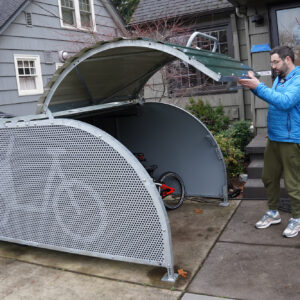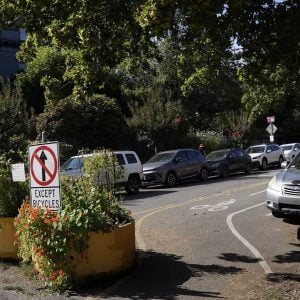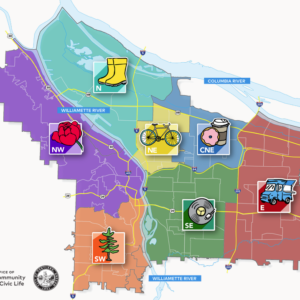
This guest post by contributor Ted Timmons is part of NW Portland Week.
Since it’s “Northwest Portland week” here on BikePortland I thought I’d give a quick tour of my neighborhood, which is what I think of as “NW Portland”: north of Lovejoy, west of 405. There are several names for it- Nob Hill, 23rd, Slabtown- but “NW” seems to be the easiest. Sometimes I say “west of Pearl” or “west of Downtown”, but that’s awkward because people think of Beaverton.
So, I went on a little ride through the area to show some of the current construction. If you haven’t been to this neighborhood in the past year or two, you might not be aware of it.
19th and Overton, replacing this low-slung building. The new building has a tall first floor- perhaps 20-25ft to the ceiling. I assume that’s for the mechanical parking system.

1950 Overton (guessing on that address), replacing this industrial building. This is the Tess O’Brien Apartments, which goes through to Pettygrove. Note there are 126 micro-apartments and no parking.

1950 Pettygrove (guessing), replacing this empty parking lot. This is the “far side” of the Tess O’Brien Apartments.

20th and Pettygrove, replacing this low-slung office building. I can’t find any design documents on this.

21st and Pettygrove to 21st and Quimby, replacing this tilt-up warehouse. Note the wall sections that are being preserved. This development is called Q21; here are the renderings on NextPortland.


This construction is complete. It’s a very large New Seasons.

These two light industrial buildings near 2350 Quimby are getting some creative adaptation. I don’t know what will be going in there- perhaps an office? Retail? I can’t find any design documents on this.

This is at 25th and Raleigh, replacing a single-family home with a new single-family home. The city’s justification is given on page 6 of this document. Note the NIMBY/incumbent sign on their neighbor’s walkway. Awkward.


Advertisement
This panorama shows the lots surrounding the old Besaws location at 23rd and Savier. The Besaws building remains standing (with the blue tarp) but three old houses were removed on Savier and one old (light commercial) house on 23rd. The property management company that owns the Besaws building owns that lot, and has ambitions to put up a development there. They fought to keep the name ‘Besaws’ to refer to the property, and the restaurant gets to use the name ‘Besaws’ to refer to the restaurant, which is a few blocks away now. Confusing.

There’s more construction in the area, but these are the ones that have been active recently. For instance, there was an industrial knockdown at 28th/Thurman, the building is absentee-owned and had some serious structural issues. The lot is for sale now. There’s also the Slabtown location, all the land that used to be owned by Con-Way Trucking, the 2240 Pettygrove building, the huge hostel building, the list goes on.
As Portlanders we should all be happy about this development. Northwest Portland has been targeted for this construction for a long time now- the planning began in 2000 and was adopted in 2003, and I remember the Con-Way land planning in 2008.
Previously the NW District contained light industrial buildings and apartments. The surrounding area has been Portland’s multi-family housing hub for well over a century! It’s a great place to build 4-8 story apartments and condos because, for the most part, the area doesn’t have historic or otherwise notable buildings. Additionally, the new building sizes aren’t out of character, making these dissimilar to other recent developments along Hawthorne Blvd and other neighborhoods that cause some controversy. It’s reasonable to have car-light development, since there are several great transit lines and amenities (restaurants, groceries, retail) within walking/biking distance that South Waterfront is still lacking.
– Ted Timmons, @tedder42







Thanks for reading.
BikePortland has served this community with independent community journalism since 2005. We rely on subscriptions from readers like you to survive. Your financial support is vital in keeping this valuable resource alive and well.
Please subscribe today to strengthen and expand our work.
Did I miss this one in the article? Footprint NW
http://liveatfootprint.com/properties/footprint-nw/
https://goo.gl/maps/9PfptBmpfEz
Nah, that one’s done. Plus I forgot because I rarely ride on that street- oops 🙂
20th and Pettygrove followed the Community Design Standards, which means they bypassed Design Review and followed a prescriptive set of standards. That’s why you wouldn’t have found published designs for it.
2360 NW Quimby, believe it or not, is going to be a single family residence.
You have to enjoy some irony when the shoe is on the other foot and people react to SINGLE FAMILY built in a very multifamily neighborhood. Not that it’s wrong…
Believe it or not, 2350 Quimby will be a single family home.
This was interesting. Even though I have worked in the Pearl and downtown for years, I haven’t gone up to NW in a while. Now I feel I need to take a day to walk around and explore again!
“It’s reasonable to have car-light development, since there are several great transit lines”
There may be great transit service in the future, if the North Central Service Enhancement Plan gets implemented. It definitely isn’t great now, especially north of Lovejoy.
http://future.trimet.org/northcentral
Yeah, and the transit service is actually worse than it was five years ago. The 77 used to run on Lovejoy / Northrup, but now runs on Everett/Glisan. That makes for a more direct routing to the Steel Bridge, which is good, but comes at the expense of service to the North end of NW/the Pearl. Additionally the streetcar used to run every 12 minutes to NW 23rd. Since the opening of the eastside loop it now only runs every 15 minutes.
“Previously the NW District contained light industrial buildings and apartments. The surrounding area has been Portland’s multi-family housing hub for well over a century!”
— this is partly true because other hubs have been demolished over time
>Sigh< I can still remember playing Irish tunes in the old Bridgeport Brewery (pre-remodel). The smell of beer and handmade pizza…and dog food coming from the Purina plant next door (where the Safeway is now). Sketchy people everywhere. the "Pearl" wasn't a thing. Farewell to the old and welcome the new!
PS: I rode by bike back then, too!
Sigh. The Bridgeport is simply unbearable now.
Well, can’t expect much, the ownership is in Texas now…they ran their Hawthorne pub into the ground, I’m guessing due to having no idea what people in that part of town wanted from a bar.
The old Bridgeport was incompatible with the new crowd. Progress!
The old Bridgeport was also located in a seismically unsound building. A major aspect of the renovation was a seismic retrofit, which I think we’ll be glad of when the big one comes.
I don’t think it was the earthquake retrofit that ruined the place. But hey, that’s just my opinion… there’s obviously a new demographic that prefers the Rock Bottom/McCormick & Schmick’s type experience.
Unbearable to you. It is usually quite crowded, so others apparently do not feel the same way.
You’re right. And that’s why I’m sad.
What does it cost to live in these places? It’s going to be intense once all the apartment buildings are finished and filled with yuppies I mean residents.
Is Portland going to be one of those cities with huge crowds of complete strangers filling the sidewalks day in and day out?
Does anyone reading this remember when that whole district was just warehouses?
What a trip.
you call them yuppies, but I think they are just people.
Just because people make different choices than you or have different values that you don’t approve of does not make you better than them.
You live in a city of 600,000 people, not Mayberry.
Portland Metro area is what, 2.5 million now?
With luck, we can catch up with Seattle, and show them who’s boss!
I like riding through that area and looking at the construction going on.
Most of the multifamily buildings being built are at least tolerable Ti the eye, some are nice.
It will be interesting to see how the cycling in those streets changes as the area becomes more populous. The city should probably have some greenway routes picked out. Right now they aren’t needed, but give it a decade.
I know this is a little closer to the river, but I can’t wait for them to tear down the post office and get some good mixed use going in there! It’s such a huge impediment to connectivity in that area currently!
And I’m so stoked to see the Conway lots slowly being eroded for something actually useful!
1. What percentage of the units is designated affordable housing?
2. Are any of the buildings mixed use?
The amount of construction going on is truly mind blowing. I moved into the Pearl in August and there are at least a half dozen buildings under construction I pass every day.
“As Portlanders we should all be happy about this development”- I can not be happy about the added noise, pollution, destruction of old houses and their replacement by monstrosities like the one constructed next to The Stepping Stone cafe (a gigantic glass ziggurat) and above all by the lack of concern for the homeless and for those without much cash. As a NW Portland resident for many years I have seen the increase in the number of people sleeping under Freeway passes and in Forest Park. Before we add yet one more condo complex let us make sure that EVERYONE has a home. I am not happy about all these new buildings when what one of the Street Roots vendors told me- “I had to wait 3 years for subsidized housing. I lived 6 years on the streets. One more year would have killed me”- is a reality for many.
The sad part is that the houses that are being demolished are the ones that are the most affordable.
Your post seems to imply that new construction somehow contributes to homelessness, or at least fails to help deal with it. I don’t think that’s a fair assumption. Firstly, new units add supply to market and reduce upwards pressure on the existing apartments in NW. Secondly, the new apartments pay a lot of property tax, which the city is able use towards funding affordable housing like the Abigail (opening shortly) or the 14th & Raleigh apartments (currently receiving Design Advice). Thirdly, if the city moves ahead with Inclusionary Zoning, as many housing advocates hope, it’s important to note that it’s a tool that only works when there is a lot of new construction.
Also, according to the Portland Chronicle, there were only 4 residential demolition permits for issued in the Northwest District last year. Most of the new construction in NW is replacing surface parking or concrete warehouses. When the Con-way masterplan is fully built out I won’t miss the sea of parking that was there for decades.
Good day,
Thank you maccoinnich for your thoughtful reply.
I know well the argument that more housing built will reduce rents or house prices but in Portland the opposite is happening. More housing units built is drawing more people here, creating more demands and more displacement.
I do not know what your housing situation is but when friends in their early 80s, not wealthy, (he worked as a university adjunct and translator, she a piano teacher, they still have to work to make ends meet) have seen the rent for their tiny basement sunless apartment (around the corner from Cinema 21) jump by 30% in the last year and then they get a three month notice and places for the elderly have long waiting lists, I am not impressed by statistics and political announcements.
We have housemates and when we advertised a room opening we got dozens of desperate replies, with tales of month long searches for a place and very high rents. (We offer the rooms at a very reasonable cost.)
Only 4 demolitions of old houses? Then perhaps they are not counting the “modifications” to one hundred year old buildings and the way these are turned into “modern” houses, often destroying the beauty of the dwellings and changing the way streets look and feel. I live in the neighborhood and as I ride downtown daily I pass by many of these altered places.
My main point was that before we “are happy” because of all the new construction (as the article writer insisted) let us make sure that Portland does not become a second SF, a place affordable only to the wealthy. Before we try to attract more people let us make sure that those who live here do not live in fear of eviction or have to sleep in tents under highway passes.
The way traffic fills a road until performance has degraded to a certain level, building too much housing induces demand, which will continue until prices rise to a certain level. We will not build our way out of this crisis.
I think that is a really interesting point. (Maybe Michael Andersen could write an article on that question?) Does induced demand in the housing market work in an analogous way to induced demand ween in highway construction (http://www.planetizen.com/node/69472). More lanes of highway mean people can choose to live further from where they work and maintain a constant commute time, but more housing means that people can choose to move to the cities from the suburbs? It seems a very important question with current policy impacts. Prices certainly don’t seem to go down without development though.
Building homes definitely enables people to live in a place who would not otherwise live in that place! If we want to call that induced demand, we can.
The equivalent to “congestion” in the housing market — the thing that happens in a desirable city where you don’t “induce demand” by building — is that prices of the old buildings go up and up and up. For the most part, the high-priced cities in the United States are the ones that have (like NYC, Boston, DC and coastal California) added lots of jobs while preventing substantial population growth. (Despite a few high-profile downtown towers.)
If your city isn’t adding jobs, like most of the industrial Midwest, then your population isn’t going to rise either and you don’t have to make very many hard decisions about where to grow.
Portland recently started adding a lot of jobs. It is now facing hard decisions about where to grow.
From my perspective, the difference between building central-city homes and building freeways is that inducing people to drive has mostly bad effects, while inducing people to live in cities rather than in suburbs has some good effects and some bad effects.
The similarity to induced vehicle demand is that the dynamic is similar — building attracts growth which drives building, and it is very difficult to get ahead and stay ahead of that curve. The moral values you assign to whether it is “good” to attract more people to Portland (and they’re not primarily coming from our suburbs!) is irrelevant to the underlying dynamic.
I contend that we stand to lose a lot in an attempt to beat the economic forces that are driving the housing market. I contend that we cannot “win” and that there is no way we can build enough housing to lower prices to what years of having relatively cheap rent has conditioned us to think of as “reasonable”, just as we cannot “win” by building more highways to keep auto travel times down.
I am not anti-growth, but I do think we are on an unsustainable path, and efforts to keep our rents cheaper than other cities are doomed to fail. The sooner we acknowledge that, the better we’ll be.
My housing situation is that I’m a renter (in NW) who would like to buy a home at some point. If new housing raised the cost of existing housing I would be arguing against my own economic self interest. You say that you don’t want Portland to become another San Francisco, where only the wealthy can live; I couldn’t agree more.
What’s different about San Francisco and Portland is that it’s famously difficult to build anything in San Francisco. Many people (myself included) blame that for their housing crisis, which has been decades in the making. Looking at the 15 year average of number of building permits built 2001-2015, San Francisco permitted 2,168 units a year. In the same time frame, Portland permitted 2,926 units a year. Adjusted for population, that represents one permit for every 398 people in SF and one permit for every 211 people in PDX. In other words Portland is building housing a rate almost twice as fast as San Francisco.
Assuming you want to buy in the city, are you better off with fewer cheaper houses in poorer condition, or more, often shoddily built, houses that are newer but in nominally better condition?
I know that seems like a contradiction, but just as an example, a house recently sold in my neighborhood for just under $300K; it will be razed, and replaced with two houses that will probably go for $500K (judging by what other comparable construction has sold for).
We may be getting more units, but we are rapidly losing just those properties that can act as a bridge between renting and buying, for those that want to make that transition.
We’d be better off if we didn’t have a zoning code that made lot splitting the only option for development in much of the city.
But here’s a fun demonstration of the benefits of allowing dense development over many decades: search on Redfin for homes under $300,000 available for sale now, or sold in the last three months. There is very very little shown in inner NE or SE. There is a sudden jump in the number of properties shown west of the river. These include units in historic buildings built in the 1920s, high rise buildings built in the 1960s, and Pearl district condos built in the 2000s. When I come to buy something it’s more likely that it will be in the Pearl than in Richmond… because that’s where I can afford to buy.
As a side note, I think it’s a real shame (and growing problem) that we’re barely building any condos anywhere in the city right now.
If you want to buy a house, I don’t see what other options there are for increasing construction without dividing lots. A lot of the cheaper properties aren’t even showing up on realtors’ lists because they’re sold to developers before they even “hit the market”, as was the case with the house I mentioned. You never even had a shot.
By making cheaper houses attractive redevelopment fodder, the bottom end of the market suffers disproportionately.
There’s lots of options. We restore the multifamily zoning that traditionally existed in inner NE and SE, and allow it to develop in the same way the NW Portland did 100 years ago, with a really interesting mix of single family houses and small apartment buildings on the same block. Or we could remove the restrictions that say only one family can live in a structure otherwise allowed by the current zoning. (If we allow a 3,600 sq ft house on a site, why not allow a triplex of the same size with three 1,2000 sq ft units in it?)
The fact that we have so many restrictions on what can be built in the inner Eastside neighborhoods means that they’re rapidly becoming areas where a house is a luxury item. Despite the reputation that NW has a rich person’s area (which, as Bike Portland pointed, isn’t true) homes can be bought here for much less money than on the other side of the river.
You know I am skeptical towards any policy that encourages the loss of affordable and historic houses (such as replacing them with apartment buildings), I am somewhat perplexed about why we don’t permit more duplex conversion, which can promote reuse of existing structures without disrupting a neighborhood’s character.
where are these affordable historic homes in the inner se and ne? is a 0.7 million dollar bungalow the new affordable home?
Here’s the house I mentioned above. (I know this one because I used to ride past it a couple of times a week.) There are other properties like this, but they get snapped up as redevelopment fodder before “normal people” get a crack at them. More expensive houses rarely meet this fate, so the market skews upwards, leaving fewer opportunities for new buyers.
http://asitwasarchitecture.blogspot.com/ –> look at the 2nd entry, from April 10.